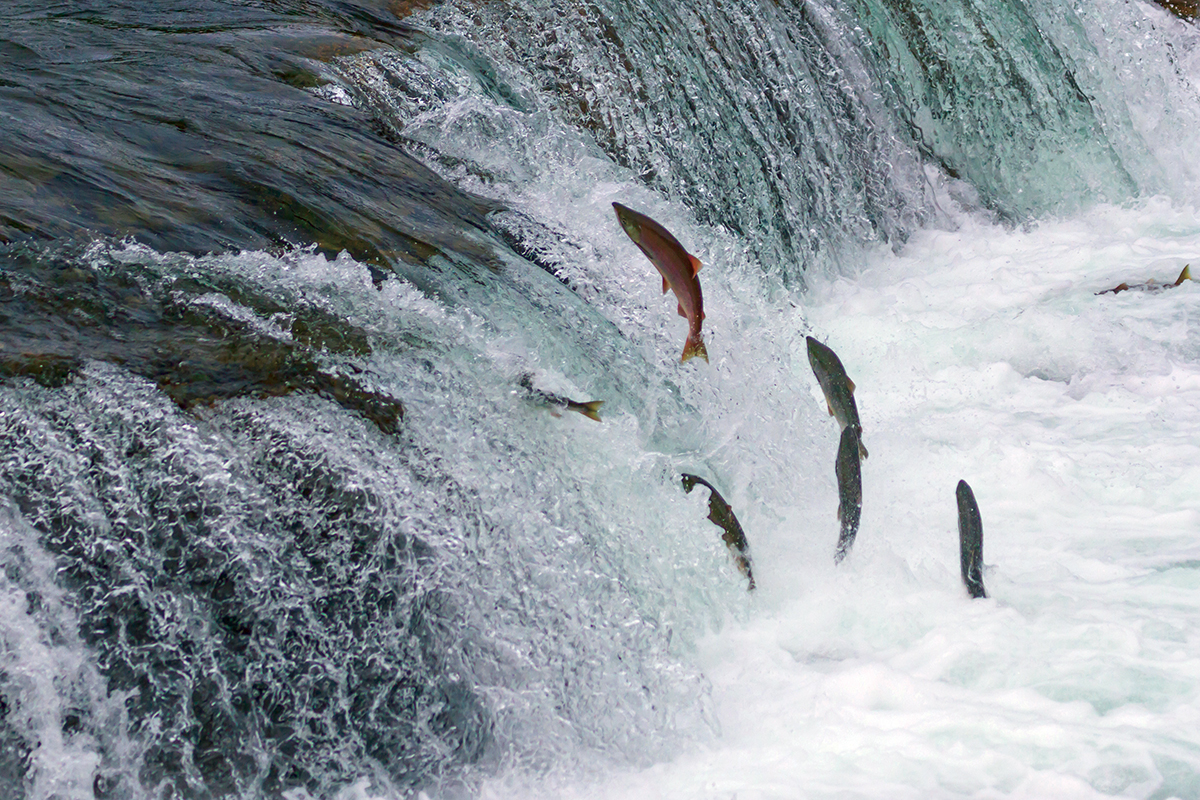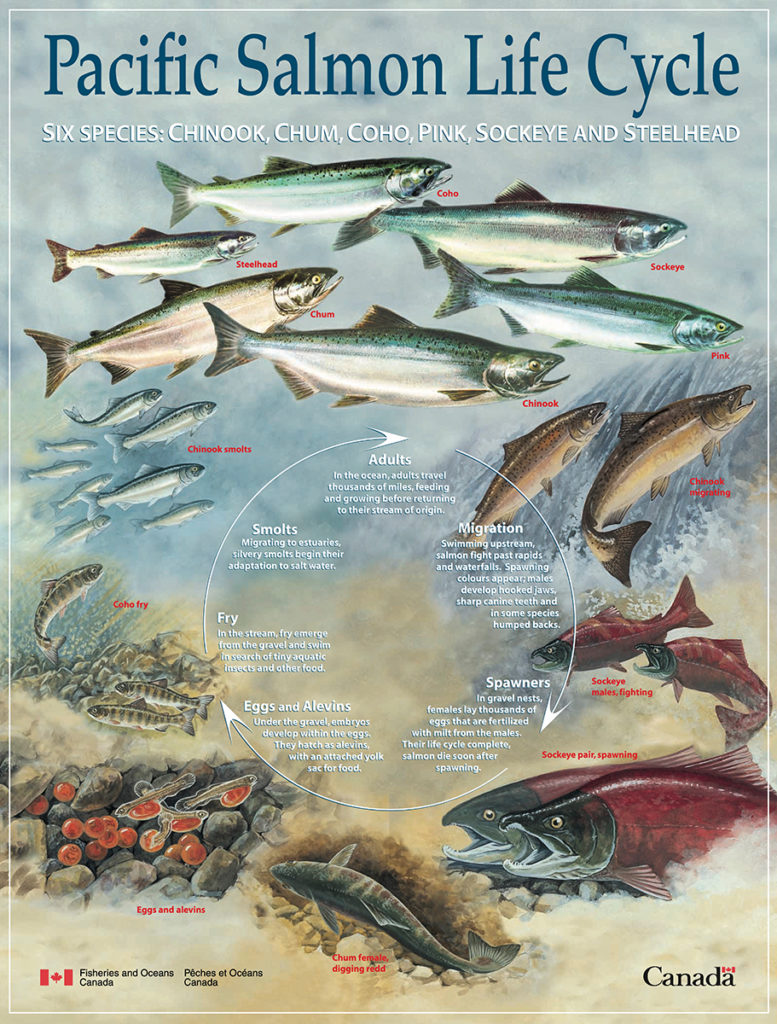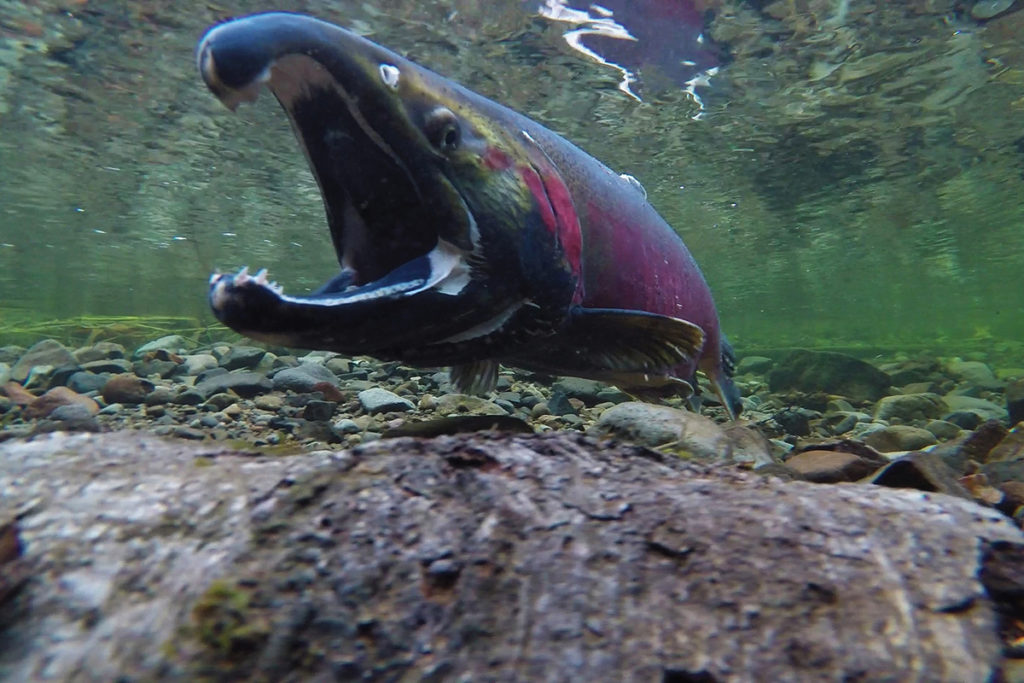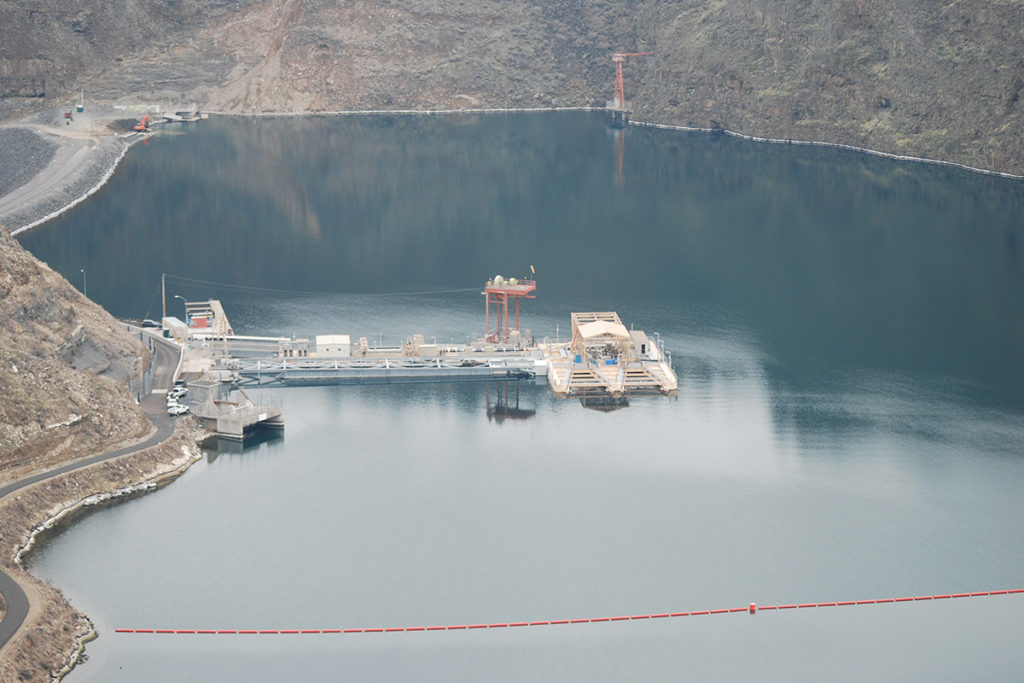Pacific salmon are in trouble. Rivers to which more than a million salmon once returned each year now receive just a fraction of their historic numbers. From the Mexican to Canadian borders, many populations of salmon—which are born in freshwater, spend most of their time at sea, and return to freshwater to spawn and die—have been designated as threatened under the Endangered Species Act, and several on the Snake and Columbia Rivers are listed under the more dire endangered status.
The demise of salmon may portend that of their ecosystems. Fish returning to their native streams sustain other forms of life, whether as prey for bears or other carnivores or by recycling nutrients to upstream ecosystems after they die and decompose. The multitude of unfortunate juvenile salmon that don’t survive the perilous journey also nourish a host of predators.
Salmon have always run a gauntlet. A fish can begin its life in freshwater streams hundreds of miles upstream from the ocean waters where it will spend its adult years. Drought may dry up the tributaries where female salmon lay their eggs in stream-bed gravel, or floods may flush the eggs away entirely. From the time tiny alevin emerge, carrying their nutritional yolk sacs with them like little lunch bags that sustain them through their first few weeks of life, until they enter estuarine mixing zones as unrecognizably transformed silvery smolt, young salmon are vulnerable to innumerable birds, mammals, and other fish. Another set of hazards awaits in the ocean: killer whales, sea lions, and other carnivores. When adult fish return upriver to spawn, land-based predators may feast on them.
Humans have multiplied the hazards to salmon. Construction and logging alter hydrology, increasing the intensity of stormwater pulses and reducing water flows between rainfalls. These activities can also smother eggs in silt, remove trees whose shade cools water below, and impose physical barriers to salmon migration. The major dams on the Columbia, Snake, and other rivers can injure or kill fish that pass through generating turbines, and the warm, slack water in the reservoirs the dams impound weaken fish and leave them more vulnerable to predators. Once adult salmon reach the ocean they may be caught by commercial, recreational, or tribal fishers. On the return trip, fish ladders intended to help salmon make their way around dams can instead make them literally fish in a barrel for hungry sea lions.
The fact that the migratory journey of the salmon is so long and diverse may provide the variability that underpins one of the fundamental principles of economics: gains from trade.
The decline of salmon is, then, a tale of death by a thousand cuts. This makes salmon recovery an expensive proposition, especially if policymakers and conservationists put maximum effort into protecting the fish at every stage of their life cycle. Should costly interventions be implemented at each stage of the life cycle to reverse the dwindling of wild salmon runs? If maximum efforts would prove too expensive, what combination of strategies might prove most cost-effective?
Economics provides both hopeful and cautionary guidance for developing cost-effective conservation strategies. The fact that the migratory journey of the salmon is so long and diverse may provide the variability that underpins one of the fundamental principles of economics: gains from trade. When different measures can be undertaken at different places and times, it may be possible to trade off the implementation of more expensive interventions at one stage for similarly effective but less expensive ones at another. For instance, it might be possible to increase the number of salmon that eventually reach the ocean by the same amount either by curtailing logging near spawning streams or by increasing water releases at a dam on a major river.
Ideally, the less costly option would be adopted first. Yet we should also remember the maxim “trust but verify.” Measures that are purported to be cost saving must, in fact, be effective. This, in turn, means that the right incentives must be in place. Widening the reach of property rights in fish may be the best way to do this.
You Need a (Salmon Restoration) Budget
Much of the recent focus on salmon restoration has been on mitigating the impacts of dams. The Bonneville Power Administration, a federal agency that markets renewable energy from dozens of hydroelectric facilities in the Northwest to private buyers, reported spending almost $500 million on salmon conservation programs in 2018. The agency forfeits millions of dollars more in potential revenue every year by spilling water to facilitate fish passage rather than generating electricity.
Costs could be even higher if one of the most controversial proposals for salmon restoration—removing dams—were implemented. Bonneville puts the cost of breaching its four dams on the Lower Snake River in southeastern Washington at between $1.3 billion and $2.6 billion. Removing the Lower Snake Dams would result in the loss of more than 3,000 megawatts of generating capacity—about enough power to supply the city of Seattle. The dams also provide irrigation water and facilitate barge navigation.
If restricting dam operations is expensive, and removing dams is very costly, then why are dams the focus of so much attention? One reason may simply be that dams are the most visibly “unnatural” modification that humans make to free-flowing rivers. This may make them seem the logical target for intervention to protect salmon. In a sense, dams are like point sources of environmental harm. Because they are large and visible, it’s relatively easy for regulators to impose requirements on them—and to determine if those requirements are being met. This is in contrast to what might be involved in restricting a multitude of relatively small, geographically dispersed, and operationally diverse nonpoint sources, such as farms, construction sites, or logging operations.
Yet one might reasonably expect that the overall burden of salmon restoration could be more cost-effective if conservation measures were more widely distributed. Dam owners and operators have attempted to do so. In 2018, Bonneville spent more than $100 million on projects such as restoring marshland habitats where young salmon rest, feed, and escape predators, and reconnecting such areas to major rivers by removing levees.
Bonneville has also purchased and acquired easements to estuarine waterfronts and other sensitive habitats whose condition affects salmon survival. On the supply side of the market, some landowners have adopted measures to help salmon in hopes of receiving compensation from fishers, utilities, or conservationists. A Habitat Farming Enterprise Program initiated by apple growers in Washington State, for example, enlisted orchard owners to replace apple trees with cottonwoods, as the latter provide much more shade and hence keep water temperatures lower on salmon streams.
By and large, however, attempts at more efficient conservation cost-sharing between dams and landowners have not prospered. The reason for this may be exemplified by the skepticism expressed in a 2016 federal district court decision. The court found in favor of the National Wildlife Federation, which had sued the National Marine Fisheries Service regarding the agency’s 2014 plan to protect salmon on the Columbia River from the threats of hydropower dams. Judge Michael Simon wrote that the salmon survival benefits claimed for habitat improvement were too speculative and uncertain to justify forgoing further restrictions on dams.
Restrictions on nonpoint sources would likely provide more certain conservation benefits if they were applied universally, rather than on a targeted basis. Nonpoint sources are, by their nature, numerous and heterogeneous. Regulations broad enough to affect anything—and everything—that fits a particular definition might reduce uncertainty about conservation consequences.
The economic argument for widening the scope of conservation measures, however, is that they can then be targeted to the spots where they would be most cost-effective. If controls on nonpoint sources are applied indiscriminately, they may not save money. For example, a series of court decisions that culminated in a 2018 U.S. Supreme Court ruling required Washington State to modify or replace more than 1,000 culverts beneath roads crossing salmon streams. The state estimates the cost of complying with the ruling to be more than a billion dollars. One has to wonder if most of the conservation benefits could be realized at a fraction of the cost by focusing on fewer culverts in the most critical locations.
Economic studies prioritizing expenditures on habitat for terrestrial endangered species often find that most of the benefits can be achieved at a fraction of the cost of protecting all areas; it seems likely a similar finding would arise in the analogous context of salmon conservation. Similarly, zoning standards that restrict development near salmon streams may be ham-fisted instruments if they are applied across properties of very different economic and ecological value.
Owning the Dam and the Fish
The costs of many proposals for salmon restoration are high either because they fall on a relatively small number of large dams or because they are applied with too broad a brush. When attempts have been made to share the burden of compliance between dams and landowners more cost-effectively, they have been met with doubts that they would be effective.
This raises an interesting question: What if not only the burden but also the benefits of salmon conservation were better targeted? What would happen if a dam operator had powerful and direct incentives to assure that cost-cutting measures also guaranteed conservation success? What would happen if it owned the dam and the fish?
This is the type of hypothetical that is often posed in environmental economics courses, where it is referred to as “internalizing the externality.” In the case of dams and fish, though, there is at least one real-world example of this thought experiment. Salmon had been in decline on the Deschutes River in northern Oregon, a tributary of the Columbia, since Portland General Electric began construction of the Pelton Round Butte Dam Complex in the mid-1960s. The Confederated Tribes of Warm Springs, a consortium of local Native American groups, were guaranteed the right to fish for salmon on the Deschutes River under an 1855 treaty. As salmon declined, the tribes faced both economic and cultural impoverishment. Controversy and finger-pointing attended discussions of the causes of the salmon decline, with the tribes blaming the Portland General Electric dams and the utility pointing to both up- and downstream threats to salmon.
An innovative solution was available in this case, however, because the tribes had a few advantages that other groups interested in conserving salmon might not. First, they had a unified and concentrated interest in salmon conservation. Second, they had leverage. They owned much of the land on which the dams were built. Moreover, hydroelectric dam operators are required to relicense their facilities at regular intervals by application to the Federal Energy Regulatory Commission. Other parties can bid for the license. So when the Pelton Round Butte Dams came up for relicensing in the early 2000s, the tribes were prepared to play hardball: They threatened to compete for the license.
The key is to give the same party incentives both to earn money and save fish—or, really, to give them incentives to earn money by saving fish. More than a half-century of work on fisheries economics has underscored a key point: Property rights are essential to efficient fishery management.
A compromise was struck. The tribes purchased an ownership share in the Portland General Electric dam complex. This diversification of shareholder interests has led to a better balance between electricity generation and salmon conservation. While salmon runs are naturally variable, measures adopted since the change in ownership have been credited with contributing to record fish returns in recent years.
The joint owners now have direct and powerful incentives both to preserve salmon and economize on the costs of doing so. The utility and tribes now combine on a variety of efforts to protect salmon. They have invested more than $10 million to improve upstream salmon habitat by removing barriers and fencing out livestock, restored a daily average of almost 33 million gallons of in-stream water flow, and spent more than $100 million to construct a 273-foot-deep selective water withdrawal system to control temperatures in the water streams in which salmon migrate.
While there are still some controversies involving salmon management on the Deschutes, and more study would be required to tell whether the combination of measures now in place is truly cost-effective, it is reasonable to suppose that shared ownership has aligned incentives better and improved management.
Property Rights in Fish Big and Small
Could the Pelton Round Butte outcome be replicated more broadly? Realistically, the combination of factors that made for success is likely to be rare. It is unlikely that many settings would feature a conservation group as cohesive and well-aligned in its interests as the tribes, a focus on just one or two dams, and the opportunity to apply legal and regulatory leverage to affect a solution.
What the example underscores more broadly, though, is the importance of ownership rights in assuring efficient resource management. The key is to give the same party incentives both to earn money and save fish—or, really, to give them incentives to earn money by saving fish. More than a half-century of work on fisheries economics has underscored a key point: Property rights are essential to efficient fishery management. This has led to a variety of proposals to assign property rights to mature fish.
Fisheries economists are virtually unanimous in their support for such systems, which are alternatively referred to as catch shares, individual fishing quotas, or individual tradable quotas. Such a quota is a property right: the right to catch a fish. The quotas are tradable; if you are better positioned to catch fish than I am, I can sell you my quota. While formal, codified systems of tradable quotas are a relatively recent innovation in fisheries management, they are becoming more widely adopted, with demonstrated ecological and economic benefits.
Quotas are typically assigned for catching fish in the ocean. Suppose, though, that a dam operator could generate tradable quotas it could sell to fishers based on the number of salmon that survive its dams. It would then have a greater incentive to assure that more fish survive passage down (and later up) the river. Moreover, the dam operator might also have a powerful incentive to subsidize upstream habitat protection measures that really are cost-effective in preserving salmon eggs and hatchlings. The operator would in a sense be buying juvenile fish from upstream landowners who have preserved habitat for them, protecting the fish until they mature, and then selling quota to downstream fishers to catch the adult salmon. Rather than leaving questions concerning the efficacy of habitat conservation programs to regulators and courts, the organizations paying to conserve habitat would have an incentive to assure it works.
Finally, dam operators would have an incentive to resolve the most contentious issue they now face. The dam would, in effect, be a generator of both electricity and of fish. If the owner found it would be more profitable to generate solely fish rather than both fish and electricity, it could decide to demolish the dam.
These suggestions may seem pie-in-the-sky now. Tradable fishing quotas are not even in place in many salmon fisheries yet. It’s certainly premature, then, to suggest that additional quotas could be generated in the upstream reaches that stock those fisheries. A host of legal and technical issues would need to be resolved before such property rights could be established. On the one hand, their complexity should not be understated. On the other hand, though, experience with property rights shows their potential not only in managing fisheries efficiently and cost-effectively but also in reducing the unproductive finger-pointing that results when costs must be borne without realizing attendant benefits. Wild Pacific salmon are in trouble. It’s worth experimenting with new approaches to rescue them.







